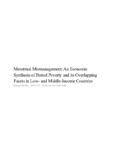Menstrual Mismanagement: An Economic Synthesis of Period Poverty and its Overlapping Facets in Low- and Middle-Income Countries

View/
Author
Bartley, Bridget Ann
Subject
Washington and Lee University, Shepherd Poverty Program
Menstruation
Public health
Human services
Poverty
Metadata
Show full item recordDescription
Capstone; [FULL-TEXT FREELY AVAILABLE ONLINE] Bridget Ann Bartley is a member of the Class of 2021 of Washington and Lee University. Existing literature splits experiences of menstrual poverty across hardware and software deprivation lines. . . . This paper will focus on both facets of period poverty specifically in low- and middle-income countries. It will begin with a theory-based economic modeling analysis which examines externalities and the current marginal costs and marginal benefits of menstrual health provisions. Once the theory is explained, the analysis will attempt to assign example-based values to the efficient level of menstrual health provisions and the price associated with achieving such an efficient level. As opposed to keeping the experiences of each facet of menstrual poverty separate, I will then synthesize any overlaps that exist between the hardware and software facets of period poverty. This analysis will be completed in an attempt to guide policy toward an efficient starting place. The theory-based answers provide a surface level look at what should be done. The examination of what goes into a high menstrual health status will depict a more detailed image of what period poverty alleviation strategies could look like. If one facet of menstrual poverty accentuates the other with greater power, it may be a good idea to guide policy toward the catalyzing facet first. However, I hypothesize that they will both heighten the impacts of each other—they are contingent upon one another—and policy should be urgently pointed towards alleviating both facets of period poverty to move forward towards a society without extreme poverty. [From Introduction]